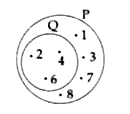If A=ϕ, then find each of the following :
(i) P(A)
(ii) P(P(A))
(iii) P{P(P(A))}.
The correct Answer is:(i) P(A)={ϕ}
(ii) P(P(A))={ϕ,{ϕ}}
(iii) P{P(P(A))}={ϕ,{ϕ},{{ϕ}},{ϕ,{ϕ}}}
To solve the problem step by step, we need to find the power set of the empty set (denoted as A=φ) and then find the power sets of the resulting sets in each part of the question.
Solution:
1. Finding P(A):
- Given A=φ (the empty set).
- The power set P(A) is the set of all subsets of A.
- The only subset of the empty set is the empty set itself.
- Therefore, P(A)={φ}.
2. Finding P(P(A)):
- Now we need to find the power set of P(A).
- From the previous step, we found P(A)={φ}.
- The subsets of P(A) are:
- The empty set φ.
- The set {φ} itself.
- Therefore, P(P(A))={φ,{φ}}.
3. Finding P(P(P(A))):
- Now we need to find the power set of P(P(A)).
- From the previous step, we found P(P(A))={φ,{φ}}.
- The subsets of P(P(A)) are:
- The empty set φ.
- The set {φ}.
- The set {{φ}}.
- The set {φ,{φ}} itself.
- Therefore, P(P(P(A)))={φ,{φ},{{φ}},{φ,{φ}}}.
Final Answers:
- (i) P(A)={φ}
- (ii) P(P(A))={φ,{φ}}
- (iii) P(P(P(A)))={φ,{φ},{{φ}},{φ,{φ}}}
- Given A=φ (the empty set).
- The power set P(A) is the set of all subsets of A.
- The only subset of the empty set is the empty set itself.
- Therefore, P(A)={φ}.
- Now we need to find the power set of P(A).
- From the previous step, we found P(A)={φ}.
- The subsets of P(A) are:
- The empty set φ.
- The set {φ} itself.
- Therefore, P(P(A))={φ,{φ}}.
- Now we need to find the power set of P(P(A)).
- From the previous step, we found P(P(A))={φ,{φ}}.
- The subsets of P(P(A)) are:
- The empty set φ.
- The set {φ}.
- The set {{φ}}.
- The set {φ,{φ}} itself.
- Therefore, P(P(P(A)))={φ,{φ},{{φ}},{φ,{φ}}}.
- (i) P(A)={φ}
- (ii) P(P(A))={φ,{φ}}
- (iii) P(P(P(A)))={φ,{φ},{{φ}},{φ,{φ}}}
Topper's Solved these Questions
- SETSBOOK - NAGEEN PRAKASHAN ENGLISHCHAPTER - SETSEXERCISE - Exercise 1D
28 Videos
- SETSBOOK - NAGEEN PRAKASHAN ENGLISHCHAPTER - SETSEXERCISE - Exercise 1E
15 Videos
- SETSBOOK - NAGEEN PRAKASHAN ENGLISHCHAPTER - SETSEXERCISE - Exercise 1B
10 Videos
- SEQUENCE AND SERIESBOOK - NAGEEN PRAKASHAN ENGLISHCHAPTER - SEQUENCE AND SERIESEXERCISE - Miscellaneous Exercise
32 Videos
- STATISTICSBOOK - NAGEEN PRAKASHAN ENGLISHCHAPTER - STATISTICSEXERCISE - MISCELLANEOUS EXERCISE
7 Videos
Similar Questions
Knowledge Check
Let P(n)=1+3+5+...+(2n−1)=3+n2, then which of the following is true?
(i) P (3) is correct
(ii) P (2) is correct
(iii) P(m)⇒p(m+1)
(iv) P(m) cancel(rArr) P(m+1)AP (3) is correctBP (2) is correctCP(m)⇒p(m+1)DP(m) cancel(rArr) P(m+1)
For two events A and B P(A)=613,P(B)=513 and P(A∪B)=713. Find the values of following:
(i) P(A∩B) (ii) P(A/B)
(iii) P(B/A)
View SolutionFor two events A and B P(A)=0.7,P(B)=0.5 and P(A∩B)=0.3. Find the values of following:
(i) P(A∪B) (ii) P(A/B)
(iii) P(¯¯¯A/¯¯¯B) (iv) P(¯¯¯B/¯¯¯A)
View SolutionFind the value of n from each of the following:
(i) 10.nP6=.n+1P3
(ii) 16.nP3=13.n+1P3
View SolutionIf A and B are independent events such that P(A)=0.3 and P(B)=0.5, then find the values of:
(i) P(A∩B) (ii) P(A∪B)
(iii) P(A/B) (iv) P(B/A)
View SolutionCalculate the profit or loss and profit or loss percent in each of the following cases:
(i) C.P.= Rs 4560, S.P.= Rs 5000
(ii) C.P.= Rs 2600, S.P.= Rs 2470
View SolutionCalculate the profit or loss and profit or loss percent in each of the following cases:
(i) C.P.= Rs 332, S.P.= Rs 350
(ii) C.P.= Rs 1500, S.P.= Rs 1500
View SolutionFrom the adjoining Venn , diagram , find the following sets :

(i) P (ii) Q (iii) P∪Q (iv) P∩Q
View Solution
